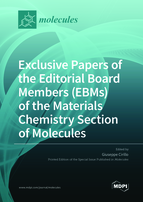Exclusive Papers of the Editorial Board Members (EBMs) of the Materials Chemistry Section of Molecules
A special issue of Molecules (ISSN 1420-3049). This special issue belongs to the section "Materials Chemistry".
Deadline for manuscript submissions: closed (31 October 2020) | Viewed by 44274
Special Issue Editor
Interests: nanomaterials; biomaterials; carbon nanostructures; composite and hybrid materials; biomedical applications of functional materials; therapeutic devices; surface chemistry
Special Issues, Collections and Topics in MDPI journals
Special Issue Information
Dear Colleagues,
This Special Issue of Molecules is dedicated to recent advances in the research area of materials chemistry and comprises a selection of exclusive papers of the Editorial Board Members (EBMs) of the Materials Chemistry Section. The section collects either research articles highlighting interesting results of the research groups of our section’s EBMs or review articles where our section’s EBMs discuss key topics in the field. This Special Issue aims to represent our young section as an attractive open-access publishing platform for Materials chemistry research.
Prof. Giuseppe Cirillo
Guest Editor
Manuscript Submission Information
Manuscripts should be submitted online at www.mdpi.com by registering and logging in to this website. Once you are registered, click here to go to the submission form. Manuscripts can be submitted until the deadline. All submissions that pass pre-check are peer-reviewed. Accepted papers will be published continuously in the journal (as soon as accepted) and will be listed together on the special issue website. Research articles, review articles as well as short communications are invited. For planned papers, a title and short abstract (about 100 words) can be sent to the Editorial Office for announcement on this website.
Submitted manuscripts should not have been published previously, nor be under consideration for publication elsewhere (except conference proceedings papers). All manuscripts are thoroughly refereed through a single-blind peer-review process. A guide for authors and other relevant information for submission of manuscripts is available on the Instructions for Authors page. Molecules is an international peer-reviewed open access semimonthly journal published by MDPI.
Please visit the Instructions for Authors page before submitting a manuscript. The Article Processing Charge (APC) for publication in this open access journal is 2700 CHF (Swiss Francs). Submitted papers should be well formatted and use good English. Authors may use MDPI's English editing service prior to publication or during author revisions.







